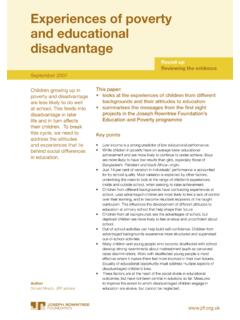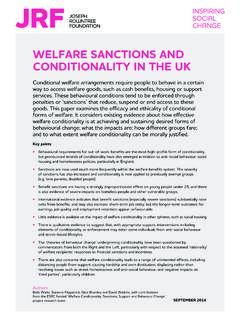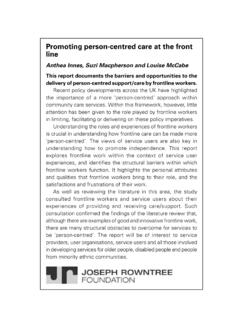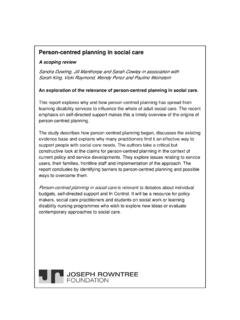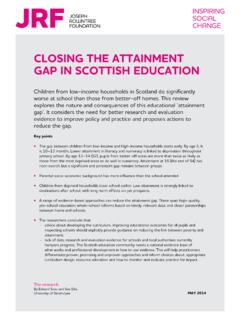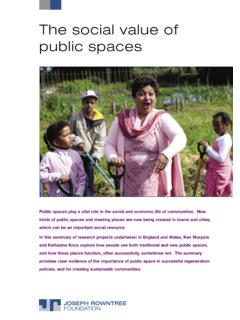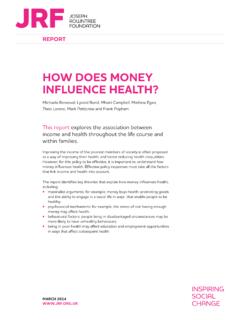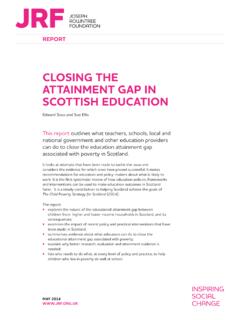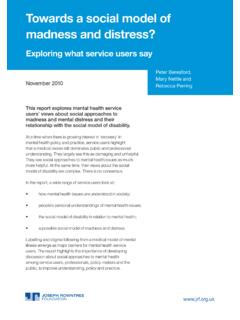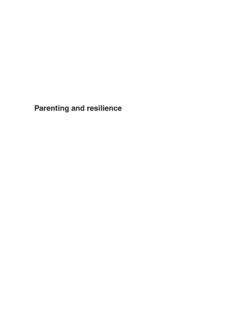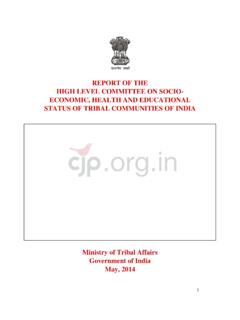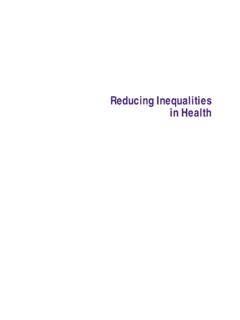Transcription of Does income inequality cause health and social problems?
1 Does income inequality cause health and social problems? Karen RowlingsonSeptember 2011 This report provides an independent review of the evidence about the impact of grew dramatically in the 1980s and has remained at a high level ever since. But should high levels of inequality concern us? This report provides an independent review of the research, paying particular attention to the evidence and arguments put forward in The Spirit Level by Richard Wilkinson and Kate Pickett, in which it was argued strongly that we should indeed be concerned about income inequality . This report reviews the points made in various critiques that have appeared since The Spirit Level was first published in 2009, alongside the evidence and debate in the broader peer-reviewed literature.
2 The report examines: whether or not there is a link between income inequality and health and social problems; who might be most affected by income inequality ; and other possible impacts of income inequality , for example, on the of figures and tables 4 Executive summary 5 Introduction 71 Is there a link between income inequality and health and social problems? 82 Does income inequality cause health and social problems? 203 Who is affected most by inequality ? 324 Does income inequality have other effects? 355 Conclusions 37 Notes 41 References 42 Acknowledgements and About the author 504 List of figures and tablesList of figures and tablesFigures1 Life expectancy at birth for men and women by social class, 2002 5 in England and Wales 92 Life expectancy at age 65 for men and women by social class.
3 2002 5 in England and Wales 93 Correlation between inequality and an index of health and social problems 114 Infant mortality by occupational class of father in Sweden compared with England and Wales 33 Tables1 The strength of relationships between income inequality in rich countries and various health and social problems 122 The strength of relationships between income inequality in rich countries and various health and social problems comparing UN data from The Spirit Level and OECD data 153 Self-reported health by income among 55 64 year olds in England and the US 345 Executive summaryExecutive summaryThe UK witnessed a dramatic growth in income inequality in the 1980s and the level of inequality has, if anything, increased further since then, albeit at a slower rate (National Equality Panel, 2010).
4 But should we be concerned about this? This report provides an independent review of the research in this field, paying particular attention to the evidence and arguments put forward in The Spirit Level, which placed income inequality firmly within public debate and argued strongly that we should indeed be concerned about it (Wilkinson and Pickett, 2009a). The scale of the ideas and data contained in The Spirit Level has attracted critique from a number of quarters, including Saunders (2010) and Snowdon (2010), among others. This report considers the points made in those critiques alongside the broader peer-reviewed literature in this field. It is not intended to be the final word on this debate, not least because new research findings are constantly being published.
5 The report is intended, instead, to contribute to the ongoing debate on this important findingsThe key findings from this review are that: The evidence from a range of studies suggests that there is indeed a correlation between income inequality and health and social problems. However, some further correlation analysis would be helpful in testing how sensitive the findings are to: different measures of social stratification; different measures of income inequality ; variations in the countries selected; and the treatment of outliers. Within any particular society, those with higher incomes do better on a range of outcomes. There is therefore a social gradient in health , which means that every step up the socio-economic ladder leads to an increase in health .
6 It is less clear whether every step up the ladder improves health by the same degree. More recent studies have moved away from simple correlation analysis to investigate whether income inequality causes health and social problems, independent of other factors. There is less agreement about whether or not there is a causal relationship, but some rigorous studies provide evidence of such a relationship. In studies which show that income inequality causes health and social problems, the size of this effect looks small in statistical terms; however, since these studies involve whole populations, the numbers of lives involved are significant. One study, for example, suggested that the loss of life from income inequality in the US in 1990 was the equivalent of the combined loss of life due to lung cancer, diabetes, motor-vehicle accidents, HIV-related causes, suicide and homicide (Lynch, et al.)
7 , 1998). Some research suggests that inequality is particularly harmful after it reaches a certain threshold. Britain was below this threshold in the 1960s, 1970s and early 1980s, but then rose past it in 1986 7 and has settled well above that threshold since 1998 9. If the threshold is indeed significant, it could provide a target for summary The most plausible explanation for income inequality s apparent effect on health and social problems is status anxiety . This suggests that income inequality is harmful because it places people in a hierarchy that increases status competition and causes stress, which leads to poor health and other negative outcomes. Further theorising around status anxiety would be helpful to consider how status anxiety works in practice, given people s different reference groups, their knowledge (or lack of knowledge) about social stratification and the complex nature of status and self-esteem.
8 Not all research studies have shown an independent effect of income inequality on health and social problems. Some studies highlight the role of other factors such as material circumstances (individual income ), culture/history, ethnicity and welfare state institutions/ social policies. Once again, the theorising behind these relationships could be further advanced and further empirical research carried out to test competing hypotheses. There has been some research comparing different groups in different countries, which suggests that those in lower socio-economic groups in more equal countries do better than those in lower socio-economic groups in more unequal countries. Indeed, they may sometimes do better than those in higher socio-economic groups in more unequal countries.
9 Further studies would be very welcome. It is sometimes suggested that income inequality may have positive effects on economic growth by providing incentives to work, but the evidence to support this is weak. This is a highly complex area both theoretically and methodologically and there is still some disagreement among academics on many related issues, but the main conclusion here is that there is some evidence that income inequality has negative effects. There is hardly any evidence that it has positive effects. Policy implicationsThe main aim of the report was to review the evidence concerning the impact of income inequality on health and social problems. However, the report concludes by considering a range of policy implications.
10 Given that the main conclusion is that both individual income (material circumstances) and income inequality (relative income ) make a difference to health and social problems, it seems clear that both need to be tackled. A range of policy levers can be used to do this: from redistribution through the tax/benefit system, to original income and wealth policies, to stronger public services to a greater focus on equal inequality grew dramatically in the UK in the 1980s and has fluctuated, if not increased still further, since then. While the Labour governments of 1997 2010 placed a high priority on poverty reduction, income inequality was not on the political agenda until Gordon Brown s premiership when, in 2008, Harriet Harman commissioned the National Equality Panel report.
